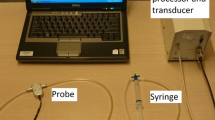Summary
Urethral pressure was investigated by a method which allowed simultaneous measurement of the crosssectional area. In healthy women a pressure range of 25–140 cm H2O was recorded at one urethral site as a response to the circumstances under which the measurement was performed. The pressures obtained were related to the change in distension. Measuring urethral pressure at one specific degree of distension results in one specific pressure value according to the dimensions of the measuring probe. However, this specific pressure value cannot be considered to supply more information on urethral sphincter function than any other pressures included in a range which can be obtained by changing the circumstances under which the measurement are carried out. More provocative methods of pressure measurement which simulate some of the physiological conditions of the urethra may provide more information on sphincter efficiency.
Similar content being viewed by others
References
Brown M, Wickham JEA (1969) The urethral pressure profile. Br J Urol 41:211
Colstrup H (1984) Rigidity of the resting femal urethra. I. Static measurements. J Urol 132:78
Colstrup H (1985) Voluntary contractions in the female urethra. J Urol 134:902
Colstrup H, Mortensen SO, Kristensen JK (1983) A probe for measurements of related values of cross-sectional area and pressure in the resting urethra. Urol Res 11:139
Enhörning G (1961) Simultaneous recording of the intravesical and intraurethral pressure. Acta Chir Scand [Suppl] 276:1
Geelen JM van, Doesburg WH, Martin CB (1984) Female urethral pressure profile; reproducibility, axial variation and effects of low dose oral contraceptives. J Urol 131:394
Gleason DM, Bottaccini MR; Reilly RJ, Byrne JC (1973) Urethral compliance and its role in female voiding dysfunctions. Invest Urol 11:83
Heidler H, Casper F, Thüroff JW (1987) Role of striated sphincter muscle in urethral closure under stress conditions: an experimental study. Urol Int 42:195
Hilton P, Stanton SL (1983) Urethral pressure measurement by microtransducer: the results in symptom-free women and in those with genuine stress incontinence. Br J Obstet Gynecol 90:919
Karlsson S (1953) Experimental studies of the function of the female urinary bladder and urethra. Acta Obstet Gynecol Scand 32:285
Lose G (1989) Mechanical properties of the resting urethra in healthy female volunteers: static measurements in the resting urethra. Neurourol Urodyn 8:451
Lose G (1989) Mechanical properties of the urethra in females with genuine stress incontinence: static measurements in the resting urethra. Neurourol Urodyn 8:461
Lose G, Colstrup H (1991) Pathophysiological subdivision of genuine stress incontinence. Neurourol Urodyn (in press)
Lose G, Colstrup H (1990) Mechanical properties of the urethra in healthy and stress incontinent females. Dynamic measurements in the resting urethra. J Urol 144:1258
Lose G, Schroeder T (1990) Pressure/cross-sectional area probe in the assessment of urethral closure function. Urol Res 18:143
Lose G, Colstrup H, Saksager K, Kristensen JK (1986) New probe for measurement of related values of cross-sectional area and pressure in a biological tube. Med Biol Eng Comp 24:488
Meyhoff HH, Nordling J, Walter S (1979) Short and long term reproducibility of urethral closure pressure profile parameters. Urol Res 7:269
Regnier CH, Susset JG, Ghoneim GM, Biancani P (1983) A new catheter to measure urethral compliance in females. Normal values. J Urol 129:1060
Sørensen S, Kirkeby HS, Djurhuus JC (1986) Continuous recording of urethral activity in healthy female volunteers. Neurourol Urodyn 5:5
Toews H (1967) Intraurethral and intravesical pressure in normal and stress incontinent women. Obstet Gynecol 29:613
Versi E, Cardozo L, Studd J, Cooper D (1986) Evaluation of urethral pressure profilometry for the diagnosis of genuine stress incontinence. World J Urol 4:6
Author information
Authors and Affiliations
Rights and permissions
About this article
Cite this article
Colstrup, H., Lose, G. & Thind, P. Urethral pressure — which one?. Urol. Res. 20, 169–172 (1992). https://doi.org/10.1007/BF00296532
Accepted:
Issue Date:
DOI: https://doi.org/10.1007/BF00296532




